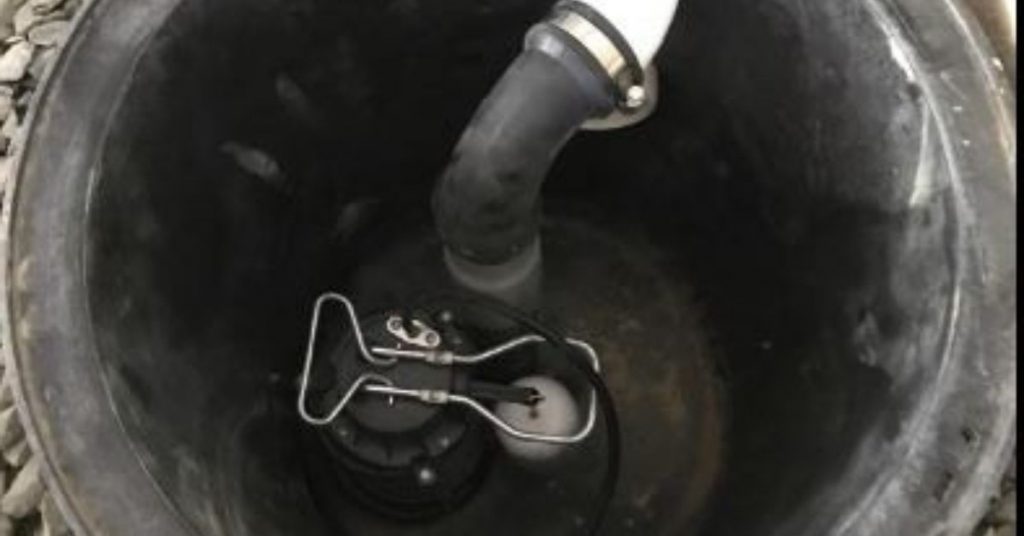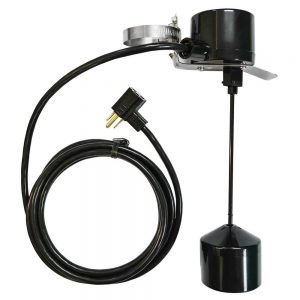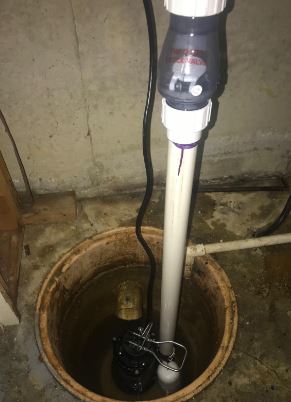
A sump pump running constantly can indicate a potential problem with your basement or crawl space drainage system. Here’s a brief summary of common reasons why a sump pump runs continuously and how to fix it:
- High Water Table:
- Cause: A consistently high water table or frequent heavy rainfall can lead to continuous sump pump operation.
- Solution: Install a higher-capacity sump pump or consider adding a secondary pump to handle increased water levels. You may also need to adjust the pump’s float switch settings.
- Improper Float Switch Placement:
- Cause: If the float switch is positioned too low or improperly adjusted, the sump pump may run unnecessarily.
- Solution: Adjust the float switch to activate the pump at a higher water level to prevent it from running constantly. Ensure it moves freely without obstructions.
- Blocked Discharge Pipe:
- Cause: A blocked or frozen discharge pipe can prevent water from being pumped out, causing the pump to run continuously.
- Solution: Inspect the discharge pipe for clogs, debris, or obstructions. Clear any blockages and ensure the pipe is properly insulated to prevent freezing.
- Failed Check Valve:
- Cause: A malfunctioning or missing check valve can allow water to flow back into the sump pit, causing the pump to cycle repeatedly.
- Solution: Check the condition of the check valve and replace it if necessary to prevent backflow.
- Pump Size Inadequacy:
- Cause: If the sump pump is undersized, you might need to replace it. It may struggle to keep up with water infiltration, leading to the sump pump constantly needed to be ran..
- Solution: Upgrade to a larger, more powerful sump pump that can handle the volume of water effectively.
- Sump Pit Size:
- Cause: An undersized sump pit can cause the pump to run continuously as it struggles to keep up with the water flow.
- Solution: Enlarge the sump pit or install a larger pit to accommodate more water and give the pump time to cycle properly.
- Leaking or Seeping Water:
- Cause: Water from cracks in the foundation or seeping through walls can enter the sump pit, causing constant pump operation.
- Solution: Seal foundation cracks and address any external water infiltration issues to reduce the amount of water entering the sump pit.
- Broken Pump:
- Cause: A malfunctioning or damaged sump pump may not operate efficiently, leading to constant running.
- Solution: Inspect the pump for any signs of damage, and if necessary, replace it with a new, reliable sump pump.
In more details, this is why your sump pump is running all the time:
1. Stuck/Jammed Float Switch
A sump pump float is a mechanical device that turns the pump on and off. It is usually connected to the float arm that connects and disconnects the switch, depending on the level of water in the sump pit.
Sump pump floats are usually made of lightweight materials like plastic and filled with air to enable them float on water. If you have seen the inside of a toilet tank, a sump pump float works pretty much like a toilet float.

When the level of water in the sump pit is low, the float is usually floating at the bottom of the pit as well. As the level of water in the pit rises, the float position rises as well, until it reaches a certain level where it triggers the switch and the pump starts running to empty the pit.
When the water in the pit falls below the set level, the float disconnects from the switch, turning off the pump. If the float is stuck or jammed against something, its free up and down movement will be impeded, and it can be stuck in the ON position resulting in the continuous running of the sump pump.
One main cause of a stuck sump pump float is the pump itself. As the pump is running, it vibrates and moves about in the pit. This movement of the pump can force the float to jam against the pump liner when it is in the ON position and hence a sump pump that will not stop running.
The float switch can also hook onto something like a pipe in the pit while in the ON position, meaning it will not turn the pump off. Debris and mineral deposits on the liner can also cause the float to stick on it.
Remove your sump pit cover to access the sump pump. Check at the position of the float switch and check if there is anything hindering its free up and down movement.
Free up the pump switch so that it so freely moving up and down relative to the level of water in the sump pit, and turning the the pump on and off as it should. If the float switch is not stuck and yet the pump won’t stop running, it has malfunctioned and will need to be replaced.
New float switches come with a schematic showing you exactly how to remove the old one and install the new one. If you would like to buy a switch float online this one from Amazon is a particularly good one.
2. Faulty Discharge Line Check Valve

A constantly running sump pump is also caused by a faulty discharge line check valve. But where exactly is this check valve?
A sump pump pumps water from the sump pit to the outside of your house. Since the sump pump and pit are located in the basement, you will need to have a vertical pipe that carries the water from the basement to the discharge area.
That pipe is called a discharge line. Gravity however causes a challenge in such an installation. Imagine a situation where the pump has already pumped water out of the pit and shut down before the water in the pipe fully exits.
What will happen is that the water will fall back down and find its way back to the sump pit causing the pump to kick in again, and hence a constantly running sump pump.
To prevent this problem from happening, a check valve is installed in the discharge line. A check valve ensures that water flows in one direction (away from the sump), preventing a backflow.
Sometimes this check valve can malfunctions, meaning it will not work as designed. When that happens, your sump pump will be running every minute.
Replacing a check valve is also very easy. You will only need a screwdriver to loosen the clamps on the old one and tighten the ones on the new one. If you do not have a check valve in your discharge line, consider installing one.
Sump pumps are usually located slightly above the pump and close to the floor to reduce the amount of water flowing back to the pump after the pump has turned off. They are easy to locate since they are slightly large than the discharge line, and often have are of a different color.
While buying a sump pump check valve, it is important to make sure that you get one which is quiet as the valves tend to be quite noisy. This one from Amazon is not a bad choice at all.
3.Underground Leak
If your sump is running all the time and the float switch and check valve are not the problem, you most likely have a leak from your underground pipes that is continuously filling the sump pit with water.
Dash to your discharge area and check if there is water running out. If indeed there is water being discharged,
- You will know that the pump is not pumping dry.
- There is a constant supply of water to the sump pit.
Is there a bad smell coming from the sump pit? That could be a sign of a leaking/burst sewer line. Another source of water to the sump pit could be a sprinkler system or leaking pool drainpipe.
Take your time to investigate the source of the leak, or engage the services of a licensed plumber. Please note that this problem will need to be addressed as fast as possible to prevent damaging your house’s foundation.
4. High Water Table
Have you lived in the house long enough to understand how the sump operates around a year? There could be a possibility that your house was built in the wrong location.
When a house is built very close to the water table or an underground spring, the sump pump must work all the time to prevent your basement from flooding. This is especially worse during the rainy season or when snow is melting.
In this case, a continuously running sump pump is to your advantage. What you can do to cushion yourself is to install a secondary sump pump just in case one fails, or having one on stand-by ready to flip the switch.
5. Wrong Size of Pump
Size does matter after all. If the size of the pump is too small relative to the size of the sump pit, your pump will need to run all the time to keep the level of water in the pit low. While this is a rare problem, you cannot completely rule it out.
The size of the sump pit is not the only one to determine if the sump pump is sufficient. The level of the water table, vertical distance of water to be pumped as well as the number of elbows in the connections also matters.
If you would like to calculate whether your sump pump is correct size, check out this post on the equation to apply.





